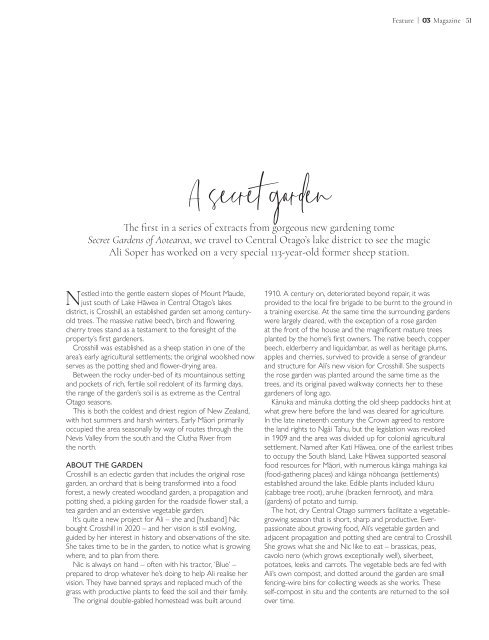03 Magazine: December 08, 2023
You also want an ePaper? Increase the reach of your titles
YUMPU automatically turns print PDFs into web optimized ePapers that Google loves.
Feature | <strong>Magazine</strong> 51<br />
A secret garden<br />
The first in a series of extracts from gorgeous new gardening tome<br />
Secret Gardens of Aotearoa, we travel to Central Otago’s lake district to see the magic<br />
Ali Soper has worked on a very special 113-year-old former sheep station.<br />
Nestled into the gentle eastern slopes of Mount Maude,<br />
just south of Lake Hāwea in Central Otago’s lakes<br />
district, is Crosshill, an established garden set among centuryold<br />
trees. The massive native beech, birch and flowering<br />
cherry trees stand as a testament to the foresight of the<br />
property’s first gardeners.<br />
Crosshill was established as a sheep station in one of the<br />
area’s early agricultural settlements; the original woolshed now<br />
serves as the potting shed and flower-drying area.<br />
Between the rocky under-bed of its mountainous setting<br />
and pockets of rich, fertile soil redolent of its farming days,<br />
the range of the garden’s soil is as extreme as the Central<br />
Otago seasons.<br />
This is both the coldest and driest region of New Zealand,<br />
with hot summers and harsh winters. Early Māori primarily<br />
occupied the area seasonally by way of routes through the<br />
Nevis Valley from the south and the Clutha River from<br />
the north.<br />
ABOUT THE GARDEN<br />
Crosshill is an eclectic garden that includes the original rose<br />
garden, an orchard that is being transformed into a food<br />
forest, a newly created woodland garden, a propagation and<br />
potting shed, a picking garden for the roadside flower stall, a<br />
tea garden and an extensive vegetable garden.<br />
It’s quite a new project for Ali – she and [husband] Nic<br />
bought Crosshill in 2020 – and her vision is still evolving,<br />
guided by her interest in history and observations of the site.<br />
She takes time to be in the garden, to notice what is growing<br />
where, and to plan from there.<br />
Nic is always on hand – often with his tractor, ‘Blue’ –<br />
prepared to drop whatever he’s doing to help Ali realise her<br />
vision. They have banned sprays and replaced much of the<br />
grass with productive plants to feed the soil and their family.<br />
The original double-gabled homestead was built around<br />
1910. A century on, deteriorated beyond repair, it was<br />
provided to the local fire brigade to be burnt to the ground in<br />
a training exercise. At the same time the surrounding gardens<br />
were largely cleared, with the exception of a rose garden<br />
at the front of the house and the magnificent mature trees<br />
planted by the home’s first owners. The native beech, copper<br />
beech, elderberry and liquidambar, as well as heritage plums,<br />
apples and cherries, survived to provide a sense of grandeur<br />
and structure for Ali’s new vision for Crosshill. She suspects<br />
the rose garden was planted around the same time as the<br />
trees, and its original paved walkway connects her to these<br />
gardeners of long ago.<br />
Kānuka and mānuka dotting the old sheep paddocks hint at<br />
what grew here before the land was cleared for agriculture.<br />
In the late nineteenth century the Crown agreed to restore<br />
the land rights to Ngāi Tahu, but the legislation was revoked<br />
in 1909 and the area was divided up for colonial agricultural<br />
settlement. Named after Kati Hāwea, one of the earliest tribes<br />
to occupy the South Island, Lake Hāwea supported seasonal<br />
food resources for Māori, with numerous kāinga mahinga kai<br />
(food-gathering places) and kāinga nōhoanga (settlements)<br />
established around the lake. Edible plants included kāuru<br />
(cabbage tree root), aruhe (bracken fernroot), and māra<br />
(gardens) of potato and turnip.<br />
The hot, dry Central Otago summers facilitate a vegetablegrowing<br />
season that is short, sharp and productive. Everpassionate<br />
about growing food, Ali’s vegetable garden and<br />
adjacent propagation and potting shed are central to Crosshill.<br />
She grows what she and Nic like to eat – brassicas, peas,<br />
cavolo nero (which grows exceptionally well), silverbeet,<br />
potatoes, leeks and carrots. The vegetable beds are fed with<br />
Ali’s own compost, and dotted around the garden are small<br />
fencing-wire bins for collecting weeds as she works. These<br />
self-compost in situ and the contents are returned to the soil<br />
over time.


















